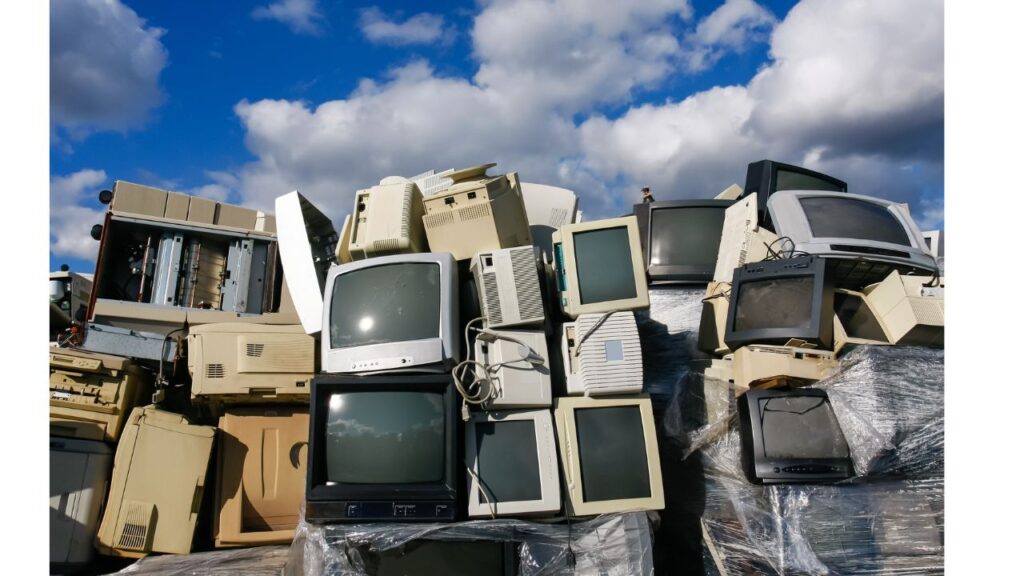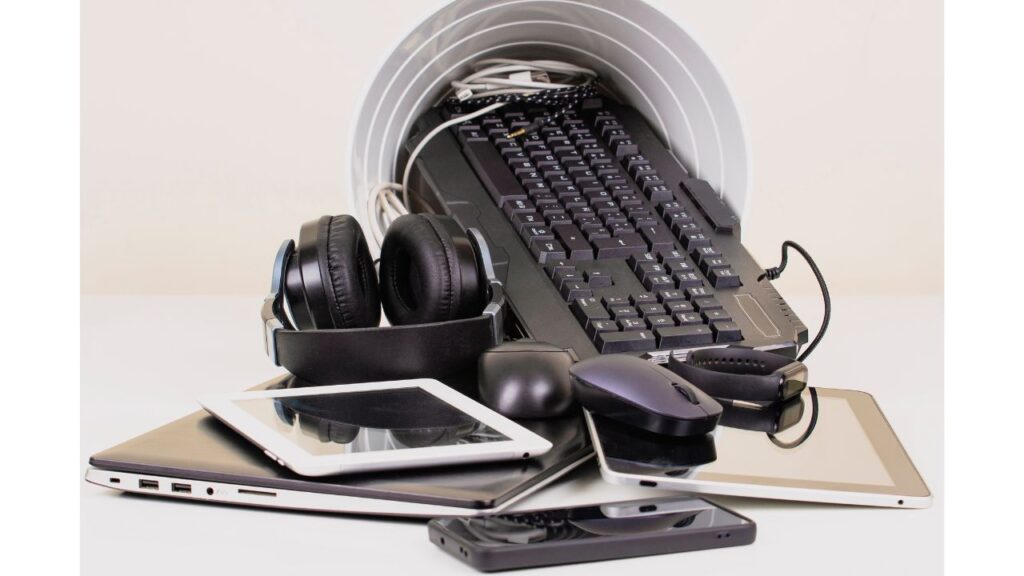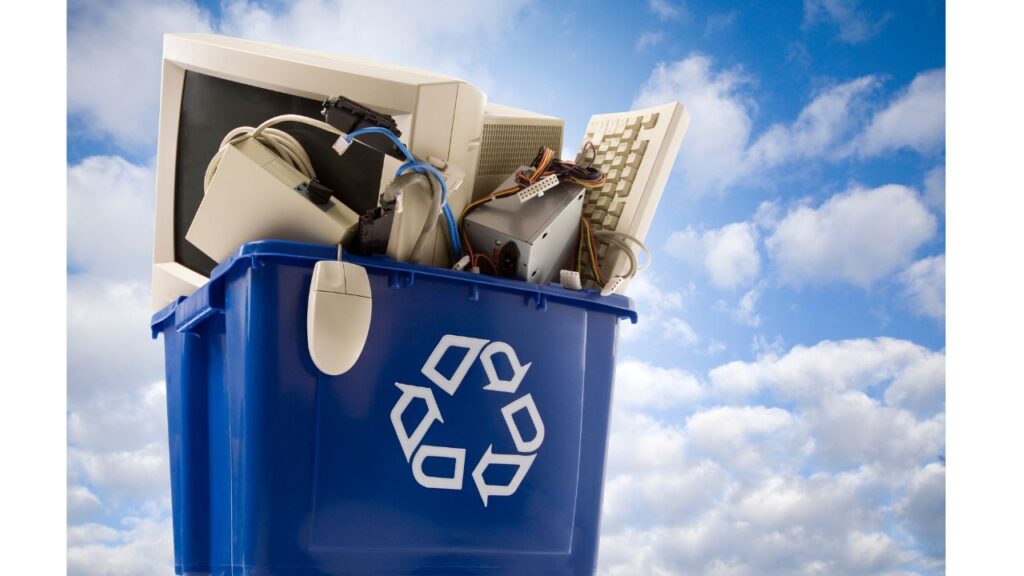Easy Ways to Recycle Your E-Waste, Don’t Trash Your Tech!
Electronic waste (e-waste) is the next headache | Blog Post by wecareearth.com |
Hey everyone, let’s talk about something that’s been on my mind lately: electronic waste, or e-waste for short. E-waste refers to electronic waste, which consists of old electrical or electronic devices that are no longer in use. This category includes a variety of items, such as outdated computers, televisions, smartphones, as well as larger appliances like refrigerators and washing machines.

We all love our gadgets, phones, laptops, tablets, the list goes on. But what happens to these devices when they become outdated, broken, or just plain unwanted? They end up in a growing mountain of e-waste, a problem that’s reaching critical levels.
What kind of electronics are considered e-waste?
E-waste encompasses a wide range of electronic devices that have reached the end of their useful life. This includes :-
– Computers (laptops, desktops, tablets)
– Phones (smartphones, cell phones)
– TVs (flat screens, CRT monitors)
– Household appliances (refrigerators, washing machines, microwaves)
– Audio equipment (stereos, speakers)
– Video equipment (DVD players, camcorders)
– Power tools (drills, saws)
– Toys (electronic games, toy cars)
Did You Know? The United States alone discards an estimated 30 million tons of electronic devices every year. That’s equivalent to throwing away 800 laptops every minute! It’s enough to fill the Empire State Building four times over!
Think about it. How many old phones do you have lying around in a drawer somewhere? What about that clunky desktop computer from a decade ago? These seemingly harmless devices are packed with a mix of materials, some precious like gold and copper, and others hazardous like lead and mercury.
Here’s the thing: the amount of e-waste we generate is staggering. According to the Global E-waste Monitor 2020 report by the United Nations, the world produced a record 53.6 million metric tons (Mt) of e-waste in 2019, and that number is expected to climb to a whopping 74.7 Mt by 2030! That’s more than the weight of all the commercial airplanes ever built!
Top Topics :-
Have You Thought, Where all these e-waste ends?
Regrettably, a large amount of electronic waste is not properly disposed of. A portion of it is dumped in landfills, leading to the release of harmful chemicals that can seep into the ground and pollute the groundwater, creating potential health hazards for the surrounding communities.
Why can’t I just throw my old electronics in the trash?
Electronic waste, or e-waste, is a combination of various materials, some of which are valuable such as gold and copper, while others are dangerous like lead, mercury, and brominated flame retardants.
If e-waste is disposed of in regular trash bins, it can result in these harmful substances seeping into the soil and water, which in turn leads to environmental pollution and health hazards.

To make matters worse, some electronic waste is sent to developing nations, where it is frequently dismantled in hazardous and unregulated environments. Picture young children toiling away in makeshift recycling facilities, inhaling toxic fumes and coming into contact with dangerous substances. This is a distressing truth that highlights the global impact of irresponsible e-waste disposal.
The Reason behind e-waste problems?
So, how did we get here? There are a few key reasons for our ever-growing mountain of e-waste :-
Planned Obsolescence
It’s a fact that a lot of tech companies intentionally create products that won’t last long. Think about that phone you purchased a couple of years back that just stopped working out of the blue after a software update. Well, that wasn’t by chance. Companies actually plan for their products to become outdated fast, so we feel the need to buy the newest version.
Rapid Innovation
The world of technology is always buzzing with the release of fresh and enhanced gadgets. It feels like every year brings a brand new phone with an upgraded camera, a quicker processor, or some other cool feature. This fast-paced innovation fuels our never-ending craving for the newest and best, causing us to toss aside perfectly functional devices before their time.
Lack of Awareness
A significant number of individuals lack knowledge on the appropriate methods of disposing of electronic waste. It is quite common for them to casually discard their outdated smartphones in regular trash bins, oblivious to the detrimental effects it can have on the environment and human health.
To address these problems, we must take a comprehensive approach. Companies should create longer-lasting items, and people should focus on fixing and reusing things. It’s also important to raise awareness and make recycling programs more available to deal with the electronic waste issue.

The Impact of E-Waste
Fortunately, there are dedicated individuals and groups who are putting in a great deal of effort to tackle the issue of electronic waste. It is heartening to see some positive advancements in this area.
Legislation
Several nations have recently begun enforcing more stringent rules regarding the disposal of electronic waste, commonly known as e-waste. These regulations aim to ensure that manufacturers take responsibility for the proper management of their products once they reach the end of their useful life. By holding manufacturers accountable, these measures seek to address the growing environmental concerns associated with the improper disposal of electronic devices.
Recycling Initiatives
Nowadays, there is an increasing array of tech waste recycling initiatives accessible to the public. These initiatives provide individuals with the opportunity to dispose of their outdated electronic devices in a safe and responsible manner.
Tech Companies Taking Responsibilities
Nowadays, there is an increasing array of electronic waste recycling initiatives accessible to the public. These initiatives provide individuals with the opportunity to dispose of their outdated electronic devices in a safe and responsible manner.
The issue of e-waste is a big concern, but there are positive signs for the future. New laws, more recycling choices, and tech companies taking more responsibility show that our electronics could have a more sustainable path ahead. It’s important to keep backing these changes and be thoughtful shoppers!
What can I do to reduce the amount of e-waste I generate?
Take good care of your electronics: The longer your devices last, the less e-waste you’ll generate. Invest in a good case for your phone and laptop to protect them from damage.
Consider buying refurbished electronics: Refurbished electronics are pre-owned devices that have been inspected, repaired, and cleaned. They can be a great way to save money and reduce electronic waste.
Think before you upgrade: Do you really need the latest and greatest gadget? If your current device is still working well, consider holding off on an upgrade.
Statistics of E-Waste
The ever-growing mountain of electronic waste, or e-waste, is a pressing global concern. Here are some eye-opening statistics to paint a clearer picture of the problem:
- Global E-waste Generation:
- In 2019, the world produced a staggering 53.6 million metric tons (Mt) of e-waste according to the Global E-waste Monitor 2020 report by the United Nations.
- This number is projected to reach a whopping 74.7 Mt by 2030, which is more than the weight of all commercial airplanes ever built!
- E-waste Growth Rate:
- E-waste is growing significantly faster than any other waste stream. Between 2010 and 2019, e-waste generation increased by roughly 60 percent.
- E-waste per Capita:
- The average global generation of e-waste per person is 7.3 kg (around 16 lbs). However, this number varies considerably by region, with developed countries generating significantly more e-waste per capita.
- United States E-waste:
- The United States discards an estimated 30 million tons of electronic devices every year. That’s equivalent to throwing away 800 laptops every minute!
- This amount of e-waste could fill the Empire State Building four times over.
- Improper E-waste Disposal:
- Only a small percentage of e-waste is recycled properly. According to the Global E-waste Monitor 2020 report, only 17.4% of e-waste in 2019 was documented as formally collected and recycled.
- Value of E-waste:
- The raw materials in the e-waste generated in 2019 were estimated to have a value of roughly USD 57 billion. However, only USD 10 billion was recovered in an environmentally accepted way.
References :-
Global E-waste Monitor 2020, United Nations: https://ewastemonitor.info/wp-content/uploads/2020/11/GEM_2020_def_july1_low.pdf
Statista, Global E-Waste – Statistics & Facts: https://www.statista.com/study/56028/global-electronic-waste/
The World Counts, Electronic Waste Facts: https://www.theworldcounts.com/challenges/planet-earth/waste/electronic-waste-facts
Easy tips for recycling old electronics
Recycling your old electronics is important for the environment, so here are a few simple suggestions to help you do it easily.

Check If it can be reused
Check to see if your electronics are still in working condition before deciding to recycle them. Consider if they could potentially be fixed with just a little bit of effort. Instead of throwing them away, think about donating them to a charity or giving them to a friend who might benefit from using them. This way, you can give your electronics a new lease on life and help someone else out in the process.
Wipe your data clean
Before getting rid of a device that stores data, it is crucial to securely erase all your personal information. By doing so, you are taking important steps to protect your privacy and prevent any potential identity theft. It is essential to ensure that no traces of your personal data remain on the device, as this could potentially be accessed by unauthorized individuals. Taking the time to securely erase your personal information is a responsible and proactive measure to safeguard your sensitive data.
Find a certified e-waste recycler
Instead of simply throwing away your electronics, it’s important to consider more responsible options. Take the time to search for certified electronic waste facilities near you. These specialized recyclers are equipped to handle electronic waste in an environmentally friendly manner, ensuring that valuable materials can be extracted and reused instead of ending up in a landfill. By choosing to recycle your electronics properly, you are not only helping to protect the environment but also contributing to the sustainable use of valuable resources.
Ask manufacturers or retailers
Numerous companies that produce and sell electronics offer programs where you can return your old devices. It’s worth visiting their websites or physical stores to find out if they will take back the electronic device you no longer need.
Look for mail-in options
Certain businesses provide electronic waste recycling programs that allow you to mail in your electronic waste. This option can be quite convenient, especially if you do not have a recycling center nearby where you can drop off your old electronics.
By following these simple steps, you can easily and responsibly recycle your old electronics, reducing environmental impact and contributing to a more sustainable future. Remember, a little effort on your part can make a big difference!
Conclusion
The issue of e-waste may seem complicated, but it is definitely not impossible to overcome. By increasing people’s understanding of the problem, encouraging them to dispose of electronic waste responsibly, and making manufacturers take responsibility for their products, we can pave the way for a more sustainable future for both our planet and ourselves. It is crucial to spread awareness about the harmful effects of e-waste and the importance of recycling electronic devices instead of simply discarding them.
Here’s a quick recap:
- E-waste is the fastest-growing waste stream globally, posing a significant threat to our environment and health.
- We can reduce e-waste by extending the lifespan of our devices, considering refurbished options, and thoughtfully upgrading.
- Responsible recycling programs and stricter regulations on manufacturers are crucial steps towards tackling this challenge.
Do you love learning about ways to live a greener life? We’re all about promoting sustainability and eco-friendly choices at We Care Earth! Our blog is packed with articles on everything from amazing green brands to tips for sustainable living, climate change awareness, and even creating your own eco-friendly garden. Come visit us and see how you can make a positive impact on the planet!
